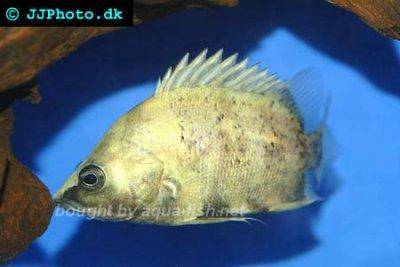New guinea tigerfish - Datnioides campbelli
Scientific name: Datnioides campbelli
Common name: New guinea tigerfish
Family: Datnioididae
Usual size in fish tanks: 30 - 40 cm (11.81 - 15.75 inch)
014
Recommended pH range: 7 - 8
Recommended water hardness: 15 - 25°N (267.86 - 446.43ppm)
0°C 32°F30°C 86°F
Recommended temperature range: 23 - 26 °C (73.4 - 78.8°F)
The way how these fish reproduce: Spawning
Where the species comes from: Oceania
Temperament to its own species: aggressive/territorial
Temperament toward other fish species: aggressive to smaller
Usual place in the tank: Middle levels
Food and Feeding
The New Guinea Tigerfish is a carnivorous species with a preference for live foods. In the wild, they hunt smaller fish and crustaceans, which reflects their dietary needs in captivity. They thrive on live or frozen foods such as whitebait, cockles, mussels, and shrimp. While they can occasionally accept beef heart, it’s essential to remove any uneaten portions to maintain water quality. With patience, these fish can be trained to accept prepared frozen foods, making them easier to care for over time. Feeding them a varied diet ensures they receive the nutrients needed for their vibrant coloration and robust health.
Origin
The New Guinea Tigerfish, scientifically known as Datnioides campbelli, is native to the freshwater and brackish habitats of Indonesia and New Guinea. These waters are characterized by moderate currents, dense vegetation, and dim lighting, which provide ample cover for these ambush predators. This region is known for its diverse aquatic ecosystems, and the New Guinea Tigerfish is a prime example of the unique biodiversity found there.
Sexing
There are no discernible physical differences between male and female New Guinea Tigerfish. This lack of sexual dimorphism can make it challenging to differentiate sexes, particularly outside of breeding conditions, which have not been observed in aquariums.
Breeding
As of now, there are no documented cases of Datnioides campbelli breeding successfully in captivity. In their natural habitat, they are believed to spawn in specific conditions that are difficult to replicate in an aquarium, including changes in water chemistry, temperature, and possibly the availability of brackish water. Efforts to study their reproductive behavior are ongoing, but little is known about their exact breeding requirements.
Lifespan
With proper care, the New Guinea Tigerfish can live between 5-8 years. Maintaining optimal water quality, a varied diet, and a suitable tank environment are crucial for ensuring their longevity and well-being.
Tank Setup and Behavior
The New Guinea Tigerfish requires a spacious tank, ideally over 250 gallons, to accommodate their large size and active swimming habits. Juveniles are relatively peaceful and may coexist with others of their kind, but adults often become territorial and aggressive, particularly toward smaller fish. For this reason, they are best kept as single specimens or in very large tanks with robust tank mates that can tolerate their assertive nature.
Decorate the tank with driftwood, rocks, and sturdy plants to mimic their natural environment while providing hiding places. A sandy substrate is recommended, as these fish are accustomed to soft, fine riverbeds. Dimmed lighting helps them feel secure and encourages natural behavior. They prefer moderate water flow to simulate the conditions of their native rivers and estuaries.
Short Description
The New Guinea Tigerfish is a rare and striking species, prized for its bold black and gold stripes and commanding presence. Reaching up to 18 inches in length, this fish is best suited for experienced aquarists with ample tank space and resources. Their territorial nature and dietary requirements make them a challenging yet rewarding addition to a well-maintained aquarium. With their unique appearance and fascinating behavior, Datnioides campbelli is a true showpiece for any advanced fishkeeping enthusiast.
Pictures
Bought by aqua-fish.net from jjphoto.dk.







 Siamese
Siamese  Siamese
Siamese  Mekong
Mekong